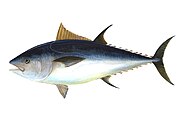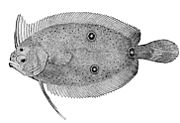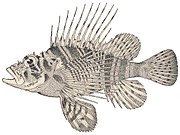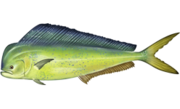Actinopterygii
| Ray-finned fish | |
|---|---|
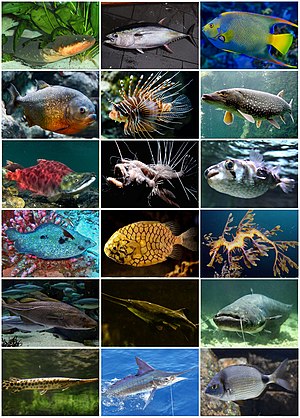 | |
| Scientific classification | |
| Domain: | Eukaryota |
| Kingdom: | Animalia |
| Phylum: | Chordata |
| Superclass: | Osteichthyes |
| Class: | Actinopterygii Klein, 1885 |
| Subclasses | |
| |
Actinopterygii (
The vast majority of actinopterygians are
Characteristics
Ray-finned fishes occur in many variant forms. The main features of typical ray-finned fish are shown in the adjacent diagram.
The
Ray-finned fishes have many different types of
Teleosts and chondrosteans (sturgeons and paddlefish) also differ from the bichirs and holosteans (bowfin and gars) in having gone through a whole-genome duplication (paleopolyploidy). The WGD is estimated to have happened about 320 million years ago in the teleosts, which on average has retained about 17% of the gene duplicates, and around 180 (124–225) million years ago in the chondrosteans . It has since happened again in some teleost lineages, like Salmonidae (80–100 million years ago) and several times independently within the Cyprinidae (in goldfish and common carp as recently as 14 million years ago). [11][12][13][14][15]
Body shapes and fin arrangements
Ray-finned fish vary in size and shape, in their feeding specializations, and in the number and arrangement of their ray-fins.
-
deeply forked tail
-
The swordfish is even faster and more streamlined than the tuna
-
tail finto jump obstacles during river migrations
-
anal fins, which give them great maneuverability
-
The four-eyed fish Anableps anableps can see both below and above the water surface
-
Fangtooth are indifferent swimmers who try to ambush their prey
-
The first spine of the dorsal fin of anglerfish is modified like a fishing rod with a lure
-
basalliving ray-fins; they possess lungs
-
European conger are ray-finned fish
-
Hawaiian turkeyfish
-
Thebenthic batfish Ogcocephalus notatus
-
Thecartilaginous endoskeleton
-
TheBelone belone
-
Seahorses are in the extended pipefish family
-
The "pectoral finsfor gliding
-
The hoodwinker sunfishcaudal fin
-
Thefilter-feederand the largest ray-finned fish to have ever lived
-
boxfish
Reproduction
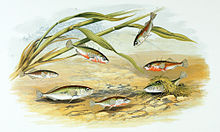
In nearly all ray-finned fish, the sexes are separate, and in most species the females spawn eggs that are fertilized externally, typically with the male inseminating the eggs after they are laid. Development then proceeds with a free-swimming larval stage.
Most families use external rather than internal fertilization.[18] Of the oviparous teleosts, most (79%) do not provide parental care.[19] Viviparity, ovoviviparity, or some form of parental care for eggs, whether by the male, the female, or both parents is seen in a significant fraction (21%) of the 422 teleost families; no care is likely the ancestral condition.[19] The oldest case of viviparity in ray-finned fish is found in Middle Triassic species of †Saurichthys.[20] Viviparity is relatively rare and is found in about 6% of living teleost species; male care is far more common than female care.[19][21] Male territoriality "preadapts" a species for evolving male parental care.[22][23]
There are a few examples of fish that self-fertilise. The mangrove rivulus is an amphibious, simultaneous hermaphrodite, producing both eggs and spawn and having internal fertilisation. This mode of reproduction may be related to the fish's habit of spending long periods out of water in the mangrove forests it inhabits. Males are occasionally produced at temperatures below 19 °C (66 °F) and can fertilise eggs that are then spawned by the female. This maintains genetic variability in a species that is otherwise highly inbred.[24]
Classification and fossil record

Actinopterygii is divided into the classes
The classification of ray-finned fishes can be summarized as follows:
- Cladistia, which include bichirs and reedfish
- Actinopteri, which include:
- Chondrostei, which include Acipenseriformes (paddlefishes and sturgeons)
- Neopterygii, which include:
- Teleostei (most living fishes)
- Holostei, which include:
- Lepisosteiformes (gars)
- Amiiformes (bowfin)
The
Vertebrates
|
| ||||||||||||||||||||||||||||||||||||||||||
The polypterids (bichirs and reedfish) are the sister lineage of all other actinopterygians, the Acipenseriformes (sturgeons and paddlefishes) are the sister lineage of Neopterygii, and Holostei (bowfin and gars) are the sister lineage of teleosts. The Elopomorpha (eels and tarpons) appear to be the most basal teleosts.[26]
The earliest known
| Chondrostei | Teleostei than their external appearance might suggest.[33]
| |
|---|---|---|
| Neopterygii | electroreception and the ampullae of Lorenzini is present in all other groups of fish, with the exception of hagfish, neopterygians have lost this sense, though it later re-evolved within Gymnotiformes and catfishes, who possess nonhomologous teleost ampullae.[34]
|












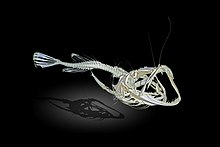
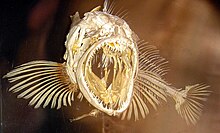

Taxonomy
The listing below is a summary of all
- Order †?AsarotiformesSchaeffer 1968
- Order †?Discordichthyiformes Minikh 1998
- Order †?Paphosisciformes Grogan & Lund 2015
- Order †?Scanilepiformes Selezneya 1985
- Order †CheirolepidiformesKazantseva-Selezneva 1977
- Order †Paramblypteriformes Heyler 1969
- Order †Rhadinichthyiformes
- Order †Palaeonisciformes Hay 1902
- Order †Tarrasiiformes sensu Lund & Poplin 2002
- Order †Ptycholepiformes Andrews et al. 1967
- Order †Haplolepidiformes Westoll 1944
- Order †Aeduelliformes Heyler 1969
- Order †Platysomiformes Aldinger 1937
- Order †Dorypteriformes Cope 1871
- Order †Eurynotiformes Sallan & Coates 2013
- Class Cladistia Pander 1860
- Order †GuildayichthyiformesLund 2000
- Order
- Order †
- Class Actinopteri Cope 1972 s.s.
- Order †Elonichthyiformes Kazantseva-Selezneva 1977
- Order †Phanerorhynchiformes
- Order †Bobasatraniiformes Berg 1940
- Order †Saurichthyiformes Aldinger 1937
- Subclass Chondrostei Müller, 1844
- Order †Birgeriiformes Heyler 1969
- Order †ChondrosteiformesAldinger, 1937
- Order Acipenseriformes Berg 1940 (includes sturgeons and paddlefishes)
- Subclass Neopterygii Regan 1923 sensu Xu & Wu 2012
- Order †PholidopleuriformesBerg 1937
- Order †Redfieldiiformes Berg 1940
- Order †PlatysiagiformesBrough 1939
- Order †Polzbergiiformes Griffith 1977
- Order †Perleidiformes Berg 1937
- Order †Louwoichthyiformes Xu 2021
- Order †Peltopleuriformes Lehman 1966
- Order †LuganoiiformesLehman 1958
- Order †Pycnodontiformes Berg 1937
- Infraclass Holostei Müller 1844
- Division Halecomorphi Cope 1872 sensu Grande & Bemis 1998
- Order †Parasemionotiformes Lehman 1966
- Order †Ionoscopiformes Grande & Bemis 1998
- Order Amiiformes Huxley 1861 sensu Grande & Bemis 1998 (bowfins)
- Division Ginglymodi Cope 1871
- Order †DapediiformesThies & Waschkewitz 2015
- Order †Semionotiformes Arambourg & Bertin 1958
- Order Lepisosteiformes Hay 1929 (gars)
- Order †
- Division Halecomorphi Cope 1872 sensu Grande & Bemis 1998
- Clade Teleosteomorpha Arratia 2000 sensu Arratia 2013
- Order †ProhaleciteiformesArratia 2017
- Division AspidorhyncheiNelson, Grand & Wilson 2016
- Order †Aspidorhynchiformes Bleeker 1859
- Order †Pachycormiformes Berg 1937
- Infraclass TeleosteiMüller 1844 sensu Arratia 2013
- Order †?Araripichthyiformes
- Order †?Ligulelliiformes Taverne 2011
- Order †?Tselfatiiformes Nelson 1994
- Order †Pholidophoriformes Berg 1940
- Order †DorsetichthyiformesNelson, Grand & Wilson 2016
- Order †Leptolepidiformes
- Order †Crossognathiformes Taverne 1989
- Order †Ichthyodectiformes Bardeck & Sprinkle 1969
- Teleocephala de Pinna 1996 s.s.
- Megacohort Elopocephalai Patterson 1977 sensu Arratia 1999 (Elopomorpha Greenwood et al. 1966)
- Order ladyfishes and tarpon)
- Order AlbuliformesGreenwood et al. 1966 sensu Forey et al. 1996 (bonefishes)
- Order halosaurs and spiny eels)
- Order Anguilliformes Jarocki 1822 sensu Goodrich 1909 (true eels)
- Order
- Megacohort Osteoglossocephalai sensu Arratia 1999
- Supercohort Osteoglossocephala sensu Arratia 1999 (Osteoglossomorpha Greenwood et al. 1966)
- Order †Lycopteriformes Chang & Chou 1977
- Order Hiodontiformes McAllister 1968 sensu Taverne 1979 (mooneye and goldeye)
- Order Osteoglossiformes Regan 1909 sensu Zhang 2004 (bony-tongued fishes)
- Supercohort Clupeocephala Patterson & Rosen 1977 sensu Arratia 2010
- Cohort Otomorpha Wiley & Johnson 2010 (Otocephala; Ostarioclupeomorpha)
- Subcohort Clupei Wiley & Johnson 2010 (ClupeomorphaGreenwood et al. 1966)
- Order †Ellimmichthyiformes Grande 1982
- Order Clupeiformes Bleeker 1859 (herrings and anchovies)
- Subcohort Alepocephali
- Order Alepocephaliformes Marshall 1962
- Subcohort Ostariophysi Sagemehl 1885
- Section Anotophysa (Rosen & Greenwood 1970) Sagemehl 1885
- Order †Sorbininardiformes Taverne 1999
- Order Gonorynchiformes Regan 1909 (milkfishes)
- Section Otophysa Garstang 1931
- Order )
- Order dourado / golden (genus Salminus) and pacu)
- Order Gymnotiformes Berg 1940 (electric eels and knifefishes)
- Order Siluriformes Cuvier 1817 sensu Hay 1929 (catfishes)
- Section Anotophysa (Rosen & Greenwood 1970) Sagemehl 1885
- Subcohort Clupei Wiley & Johnson 2010 (
- Cohort Euteleosteomorpha (Greenwood et al. 1966) (Euteleostei Greenwood 1967 sensu Johnson & Patterson 1996)
- Subcohort Lepidogalaxii
- salamanderfish)
- Subcohort Protacanthopterygii Greenwood et al. 1966 sensu Johnson & Patterson 1996
- Order slickheads) (formerly in Osmeriformes)
- Order Galaxiiformes
- Order )
- Order Esociformes Bleeker 1859 (pike)
- Order
- Subcohort Stomiati
- Order Osmeriformes (smelts)
- Order bristlemouths and marine hatchetfishes)
- Subcohort Neoteleostei Nelson 1969
- Infracohort Ateleopodia
- Order Ateleopodiformes (jellynose fish)
- Order
- Infracohort Eurypterygia Rosen 1973
- Section Aulopa [Cyclosquamata Rosen 1973]
- Order Aulopiformes Rosen 1973 (Bombay duck and lancetfishes)
- Section Ctenosquamata Rosen 1973
- Subsection Myctophata [Scopelomorpha]
- Order Myctophiformes Regan 1911 (lanternfishes)
- Subsection Acanthomorpha Betancur-Rodriguez et al. 2013
- Division Lampridacea Betancur-Rodriguez et al. 2013 [Lampridomorpha; Lampripterygii]
- Order ribbonfishes)
- Order
- Division Paracanthomorphacea sensu Grande et al. 2013 (Paracanthopterygii Greenwood 1937)
- Order trout-perches)
- Order †Sphenocephaliformes Rosen & Patterson 1969
- Order Zeiformes Regan 1909 (dories)
- Order StylephoriformesMiya et al. 2007
- Order Gadiformes Goodrich 1909 (cods)
- Order
- Division Polymixiacea Betancur-Rodriguez et al. 2013 (Polymyxiomorpha; Polymixiipterygii)
- Order †Pattersonichthyiformes Gaudant 1976
- Order †Ctenothrissiformes Berg 1937
- Order Polymixiiformes Lowe 1838 (beardfishes)
- Division Euacanthomorphacea Betancur-Rodriguez et al. 2013 (Euacanthomorpha sensu Johnson & Patterson 1993; Acanthopterygii Gouan 1770 sensu])
- Subdivision Berycimorphaceae Betancur-Rodriguez et al. 2013
- Order pineconefishes) (incl. Stephanoberyciformes; Cetomimiformes)
- Order
- Subdivision Holocentrimorphaceae Betancur-Rodriguez et al. 2013
- Order Soldierfishes)
- Order
- Subdivision Percomorphaceae Betancur-Rodriguez et al. 2013 (Acanthopteri)
- Series Ophidiimopharia Betancur-Rodriguez et al. 2013
- Order Ophidiiformes (pearlfishes)
- Series Batrachoidimopharia Betancur-Rodriguez et al. 2013
- Order Batrachoidiformes (toadfishes)
- Order
- Series Gobiomopharia Betancur-Rodriguez et al. 2013
- Order cardinalfishes)
- Order gobies)
- Order
- Series Scombrimopharia Betancur-Rodriguez et al. 2013
- Order )
- Order Scombriformes (Tunas and (mackerels)
- Series Carangimopharia Betancur-Rodriguez et al. 2013
- Subseries Anabantaria Betancur-Rodriguez et al. 2014
- Order Synbranchiformes (swamp eels)
- Order Anabantiformes (Labyrinthici) (gouramies, snakeheads, )
- Subseries Carangaria Betancur-Rodriguez et al. 2014
- Carangaria incertae sedis
- Order swordfishes, billfishes)
- Order Jack mackerels, pompanos)
- Order Pleuronectiformes Bleeker 1859 (flatfishes)
- Subseries Ovalentaria Smith & Near 2012 (Stiassnyiformes sensu Li et al. 2009)
- Ovalentaria incertae sedis
- Order Convict blenny, leaf fishes)
- Order silversides and rainbowfishes)
- Order livebearers, killifishes)
- Order flyingfishes and ricefishes)
- Order Mugiliformes Berg 1940 (mullets)
- Order Blennies)
- Order Clingfishes)
- Subseries Anabantaria Betancur-Rodriguez et al. 2014
- Series Eupercaria Betancur-Rodriguez et al. 2014 (Percomorpharia Betancur-Rodriguez et al. 2013)
- Eupercaria incertae sedis
- Order Gerreiformes (Mojarras)
- Order Labriformes (Wrasses and Parrotfishes)
- Order Caproiformes (Boarfishes)
- Order Lophiiformes Garman 1899 (Anglerfishes)
- Order pufferfish)
- Order Centrarchiformes Bleeker 1859 (Sunfishes and mandarin fishes)
- Order Gasterosteiformes (Sticklebacksand relatives)
- Order Scorpaeniformes (Lionfishes and relatives)
- Order Perciformes Bleeker 1859
- Series Ophidiimopharia Betancur-Rodriguez et al. 2013
- Subdivision Berycimorphaceae Betancur-Rodriguez et al. 2013
- Division Lampridacea Betancur-Rodriguez et al. 2013 [Lampridomorpha; Lampripterygii]
- Subsection Myctophata [Scopelomorpha]
- Section Aulopa [Cyclosquamata Rosen 1973]
- Infracohort Ateleopodia
- Subcohort Lepidogalaxii
- Cohort Otomorpha Wiley & Johnson 2010 (Otocephala; Ostarioclupeomorpha)
- Supercohort Osteoglossocephala sensu Arratia 1999 (Osteoglossomorpha Greenwood et al. 1966)
- Megacohort Elopocephalai Patterson 1977 sensu Arratia 1999 (Elopomorpha Greenwood et al. 1966)
- Order †?
- Order †
- Order †
References
- S2CID 236438229.
- ISBN 978-0-07-802302-6.
- ^ ISBN 978-1-118-34233-6.
- ^ (Davis, Brian 2010).
- ^ PMID 33463017.
- PMID 33463017.
- PMID 37699889.
- PMID 32395105.
- PMID 36381998.
- ^ "Actinopterygii Klein, 1885". www.gbif.org. Retrieved 20 September 2021.
- PMID 34301898.
- PMID 35961774– via genome.cshlp.org.
- ^ The sterlet sturgeon genome sequence and the mechanisms of segmental rediploidization
- ^ Genomic reconsideration of fish non-monophyly: why cannot we simply call them all ‘fish’?
- ^ The allotetraploid origin and asymmetrical genome evolution of the common carp Cyprinus carpio
- ISBN 978-0-03-030504-7.
- S2CID 22712745.
- ^ Pitcher, T (1993). The Behavior of Teleost Fishes. London: Chapman & Hall.
- ^ PMID 11958696.
- .
- ^ Clutton-Brock, T. H. (1991). The Evolution of Parental Care. Princeton, NJ: Princeton UP.
- PMID 7382520. Retrieved 15 September 2013.
- S2CID 19242013.
- ISBN 978-1-118-89139-1.
- S2CID 24876484.
- ^ PMID 22869754.
- ^ PMID 23653398.
- .
- ^ "Fossilworks: Andreolepis". Archived from the original on 12 February 2010. Retrieved 14 May 2008.
- S2CID 241850484.
- S2CID 85808890.
- S2CID 5332637.
- ^ a b "Chondrosteans: Sturgeon Relatives". paleos.com. Archived from the original on 25 December 2010.
- ISBN 978-0-387-28275-6.
- PMID 28683774.
- ^ "Actinopterygii". Integrated Taxonomic Information System. Retrieved 3 April 2006.
- ^ R. Froese and D. Pauly, ed. (February 2006). "FishBase". Archived from the original on 5 July 2018. Retrieved 8 January 2020.
- .
- ISSN 0024-4082.
- Polypteriformes is placed in its own subclass Cladistia.
- Gasterosteiformes.
External links
 Media related to Actinopterygii at Wikimedia Commons
Media related to Actinopterygii at Wikimedia Commons Data related to Actinopterygii at Wikispecies
Data related to Actinopterygii at Wikispecies

